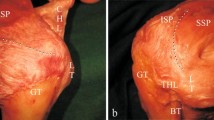Abstract
Background
Although several authors have reported on the pennation angles of intact rotator cuff muscles, the relationship between their alteration and rotator cuff tears has not been fully clarified. The purpose of this study was to measure the pennation angles of human cadaveric rotator cuff muscles with torn tendons.
Methods
Twenty embalmed cadaveric shoulders were studied. Ten shoulders with various types of rotator cuff tears (tear group) were compared with ten shoulders that had intact rotator cuff tendons (control group). In seven shoulders with full-thickness tears, the area of the tear was determined by multiplying its length and width. After removing the muscles from the scapula, the superficial muscle fibers of each muscle were removed layer by layer until the entire intramuscular tendon was exposed. Photographs were taken and the pennation angles were then measured on digital images. The correlation between the size of the tear and the pennation angles of the supraspinatus and the infraspinatus muscles were determined statistically.
Results
The pennation angles of the supraspinatus and infraspinatus muscles in the tear group were significantly greater than those in the control group (P = 0.027 and 0.007, respectively). In seven shoulders with full-thickness rotator cuff tears, a positive correlation was found between the pennation angle of the supraspinatus muscle and the tear length (r = 0.854, P = 0.014). Moreover, a positive correlation was found between the pennation angle of the infraspinatus muscle and the tear area (r = 0.759, P = 0.048). On the other hand, the pennation angle was not affected by the presence of the partial-thickness tears in the remaining three shoulders.
Discussion and conclusion
In rotator cuff tears, the pennation angles of the involved rotator cuff muscles increased with increasing size of the tear.






Similar content being viewed by others
References
Ward SR, Hentzen ER, Smallwood LH, Eastlack RK, Burns KA, Fithian DC, Friden J, Lieber RL. Rotator cuff muscle architecture: implications for glenohumeral stability. Clin Orthop Relat Res. 2006;448:157–63.
Keating JF, Waterworth P, Shaw-Dunn J, Crossan J. The relative strengths of the rotator cuff muscles. J Bone Joint Surg Br. 1993;75:l37–140.
Langenderfer JE, Patthanacharoenphon C, Carpenter JE, Hughes RE. Variability in isometric force and moment generating capacity of glenohumeral external rotator muscles. Clin Biomech (Bristol, Avon). 2006;21:701–9.
Roh MS, Wang VM, April EW, Pollock RG, Bigliani LU, Flatow EL. Anterior and posterior musculotendinous anatomy of the supraspinatus. J Should Elbow Surg. 2000;9:436–40.
Kim SY, Boynton EL, Ravichandiran K, Fung LY, Bleakney R, Agur AM. Three-dimensional study of the musculotendinous architecture of supraspinatus and its functional correlations. Clin Anat. 2007;6:648–55.
Meyer DC, Hoppeler H, von Rechenberg B, Gerber C. A pathomechanical concept explains muscle loss and fatty muscular changes following surgical tendon release. J Orthop Res. 2004;22:1004–7.
Post M, Silver R, Singh M. Rotator cuff tear: diagnosis and treatment. Clin Orthop Relat Res. 1983;173:78–91.
Ledoux WR, Hirsch BE, Church T, Caunin M. Pennation angles of the intrinsic muscles of the foot. J Biomech. 2001;34:399–403.
Lieber RL, Fridén J. Functional and clinical significance of skeletal muscle architecture. Muscle Nerve. 2000;23:1647–66.
Minagawa H, Itoi E, Sato T, Konno N, Hongo M, Sato K. Morphology of the transitional zone of intramuscular to extramuscular tendons of the rotator cuff. Katakansetsu. 1996;20:103–10.
Mochizuki T, Sugaya H, Uomizu M, Maeda K, Matsuki K, Sekiya I, Muneta T, Akita K. Humeral insertion of the supraspinatus and infraspinatus new anatomical findings regarding the footprint of the rotator cuff. J Bone Joint Surg Am. 2008;90:962–9.
Mochizuki T, Sugaya H, Uomizu M, Maeda K, Matsuki K, Sekiya I, Muneta T, Akita K. Humeral insertion of the supraspinatus and infraspinatus new anatomical findings regarding the footprint of the rotator cuff. Surgical technique. J Bone Joint Surg Am. 2009;91:1–7.
Yamaguchi K, Tetro AM, Blam O, Evanoff BA, Teefey SA, Middleton WD. Natural history of asymptomatic rotator cuff tears: a longitudinal analysis of asymptomatic tears detected sonographically. J Shoulder Elbow Surg. 2001;10:199–203.
Gerber C, Meyer DC, Schneeberger AG, Hoppeler H, von Rechenberg B. Effect of tendon release and delayed repair on the structure of the muscles of the rotator cuff: an experimental study in sheep. J Bone Joint Surg Am. 2004;86:1973–82.
Neviaser JS. Ruptures of the rotator cuff of the shoulder new concepts in the diagnosis and operative treatment of chronic ruptures. Arch Surg. 1971;102:483–5.
Nasca RJ. The use of freeze-dried allografts in the management of global rotator cuff tears. Clin Orthop Relat Res. 1988;228:218–26.
Hirooka A, Yoneda M, Wakaitani S, Isaka Y, Hayashida K, Fukushima S, Okamura K. Augmentation with a Gore-Tex patch for repair of large rotator cuff tears that cannot be sutured. J Orthop Sci. 2002;7:451–6.
Rhee YG, Cho NS, Lim CT, Yi JW, Vishvanathan T. Bridging the gap in immobile massive rotator cuff tears augmentation using the tenotomized biceps. Am J Sports Med. 2008;36:1511–8.
Sano H, Mineta M, Kita A, Itoi E. Tendon patch grafting using the long head of the biceps for irreparable massive rotator cuff tears. J Orthop Sci. 2010;15:310–6.
Acknowledgments
The authors would like to thank Professor Mari Dezawa in the Department of Anatomy and Anthropology, Tohoku University School of Medicine, for her kind cooperation in the collection of cadaveric shoulders.
Conflict of interest
The authors did not receive and will not receive any benefits or funding from any commercial party related directly or indirectly to the subject of this article.
Author information
Authors and Affiliations
Corresponding author
About this article
Cite this article
Zuo, J., Sano, H. & Itoi, E. Changes in pennation angle in rotator cuff muscles with torn tendons. J Orthop Sci 17, 58–63 (2012). https://doi.org/10.1007/s00776-011-0176-6
Received:
Accepted:
Published:
Issue Date:
DOI: https://doi.org/10.1007/s00776-011-0176-6




